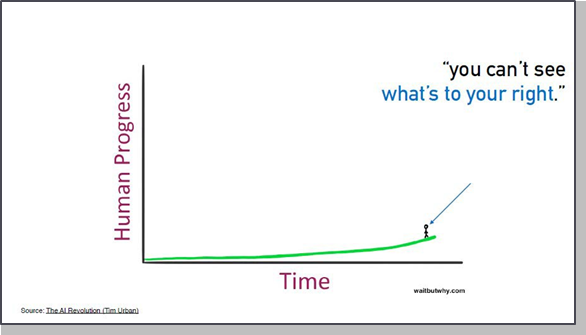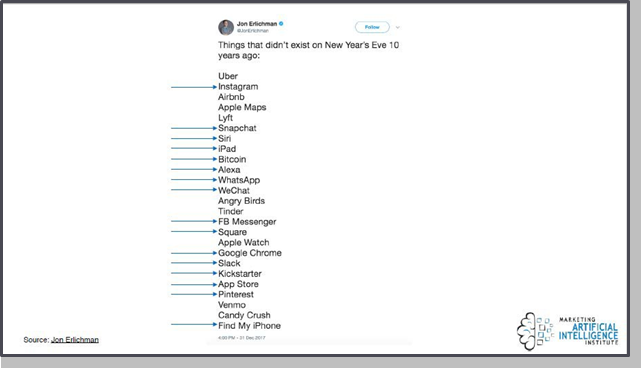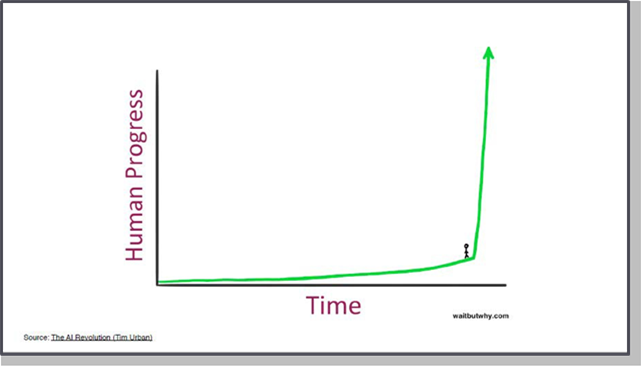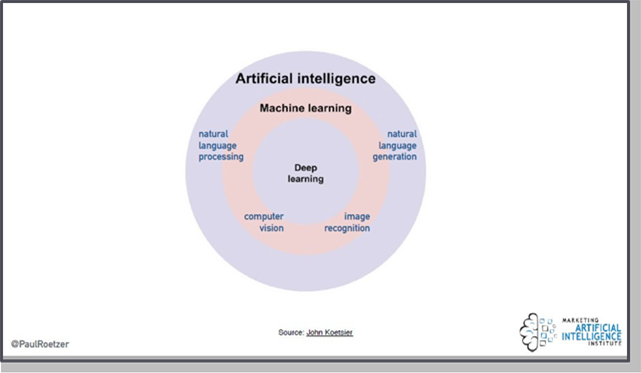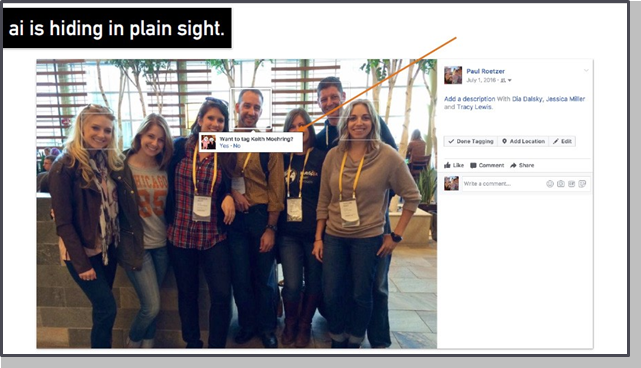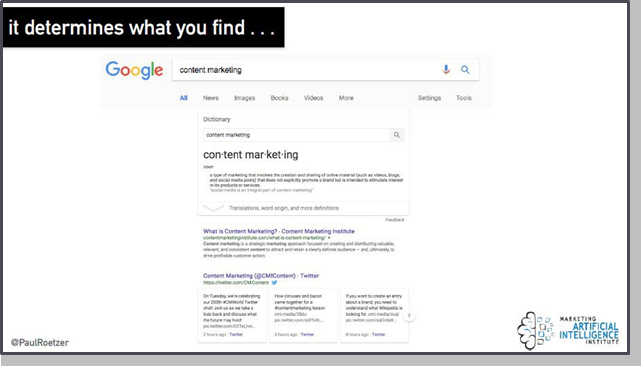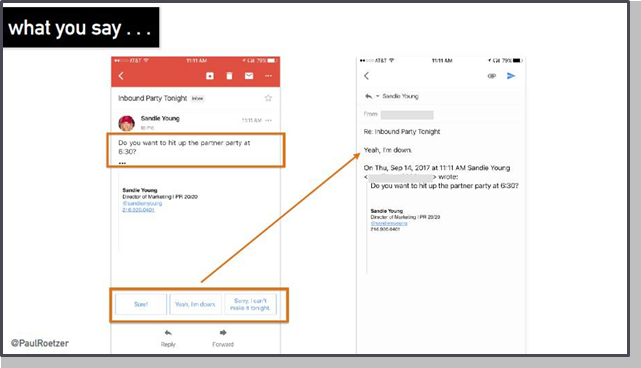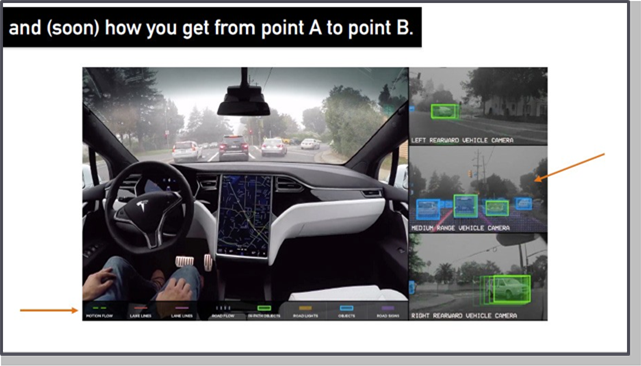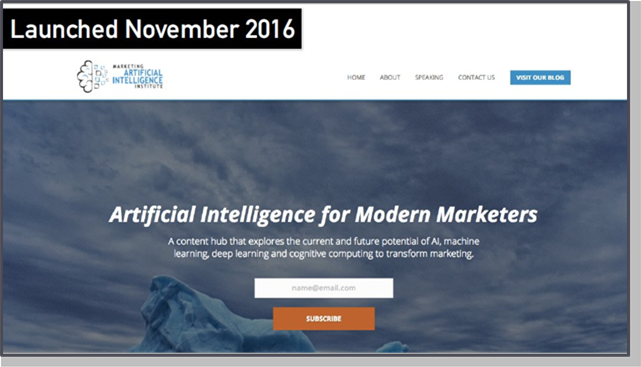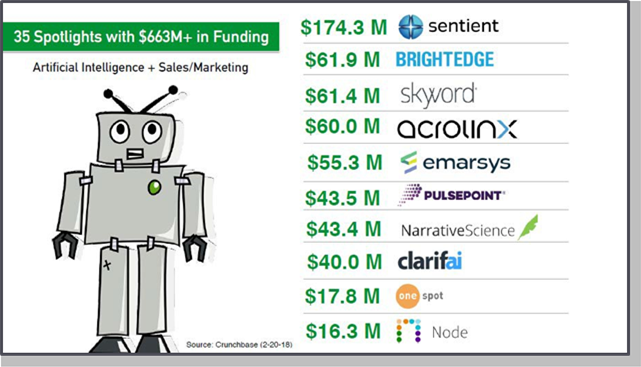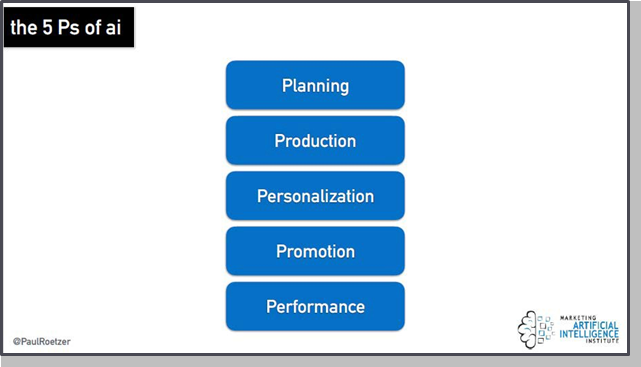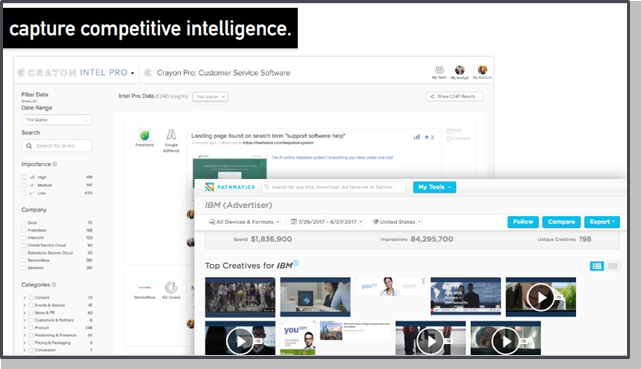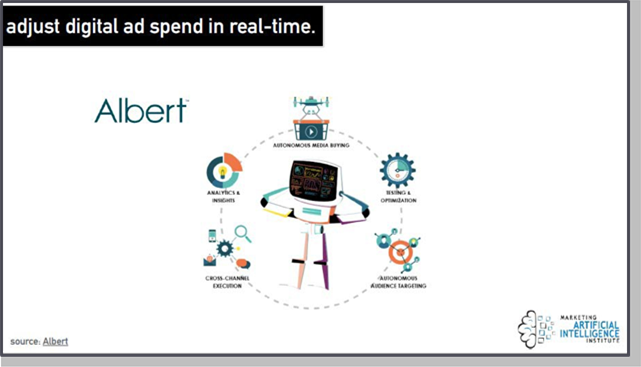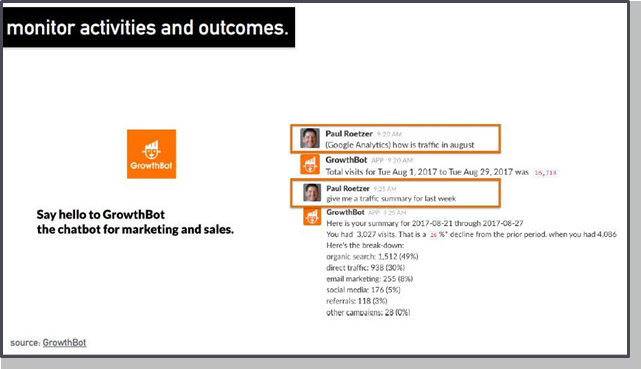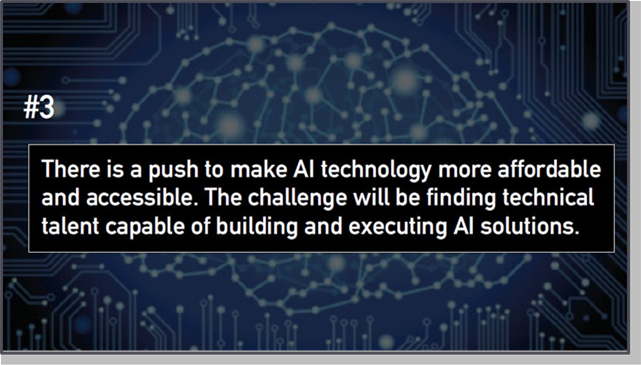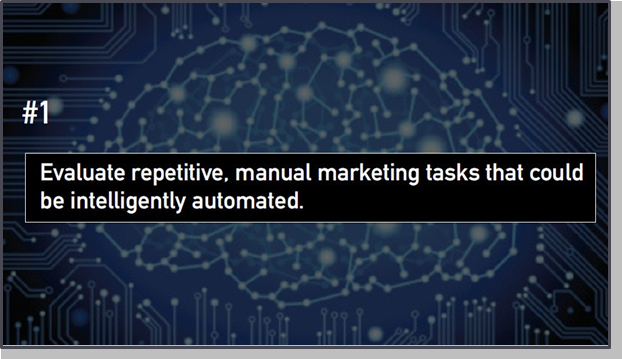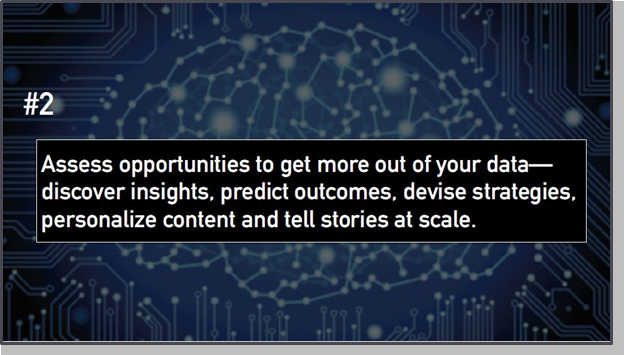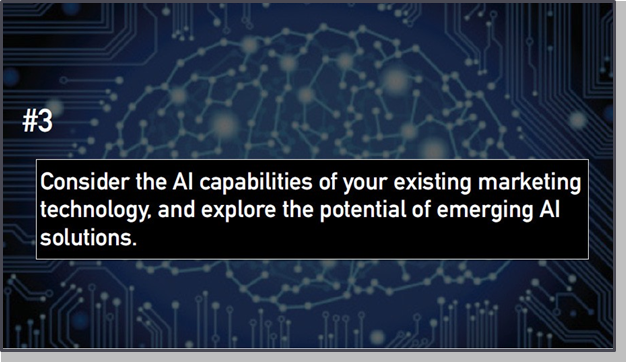Paul Roetzer
Paul Roetzer is founder and CEO of PR 20/20, a Cleveland-based content marketing agency and HubSpot’s first Agency Partner. He is author of The Marketing Performance Blueprint and The Marketing Agency Blueprint; creator of the Marketing Artificial Intelligence Institute and Marketing Score; a regular contributor to leading marketing industry blogs; and a frequent speaker.
I believe that within five years, at least 80% of what we do as an agency will be, to some degree, intelligently automated by artificial intelligence. I’m actually going to walk you through why that is and how it’s going to be possible.
One of my favorite authors is Tim Urban. If you’re not, subscribed to his Wait But Why blog yet, do it. It’s insane. He only writes, it seems, every three to six months, but he goes really deep on topics that he’s passionate about, and that’s the idea of Wait But Why. Like, why is this possible? Why does this happen? And he always has these quirky simplistic illustrations that go along with it.
his is a visualization from an article he wrote called, “The AI Revolution.” And in it, he talks about this idea that, when we’re trying to predict the future and we’re looking forward as to what will be the services we offer as a marketer — what will be the things I’m doing every day? What’s going to matter? — you can only think in a linear path as a human. You take your sum
of experiences and the things you know and the things you do and the things you’ve learned, and you try and project out what will happen over the next six months, twelve months, three years, five years.
So, imagine that that’s you standing on the end of that curve, and you’re trying to figure out what is coming next. The problem is you can’t see what’s up and to the right.
This tweet from New Year’s Eve of this past year exemplifies this perfectly. So, I was home because I have a six-year-old and a four-year-old, and on New Year’s Eve, they go to bed at 9:00 and you sit there and check your Twitter feed. A journalist from Bloomberg tweeted: Things that didn’t exist on New Year’s Eve ten years ago. Instagram. Snapchat. Siri. iPad. Bitcoin. Alexa.
I’m just highlighting some of the things that affect us as marketers and as businesses. Facebook Messenger, Square, Google Chrome, Slack, Kickstarter,
App Store, Pinterest. Find My iPhone is my favorite because the iPhone itself was only six months old at that point.
In ten years, these transformative technologies emerged that almost nobody could’ve predicted were going to happen. The reality is this is what the future looks like. It’s been up and to the right of the curve. We can’t comprehend because the technology that’s going to make it that doesn’t even exist yet, but it’s coming extremely fast, and it’s being fueled by artificial intelligence.
What is AI, and Where is It Happening Already in Our Lives?
To get started, I’m going to give you a broad scope of what AI is, just so we understand.
This is a quote from Sundar Pichai, the CEO of Google. He recently said this last month to an interview on MSNBC: “AI is one of the most important things humanity is working on. It’s more profound than, I don’t know, electricity or fire.”
The people that spend their lives in AI believe it’s going to transform everything, business, marketing, society, the economy. For us, it started with this simple question: Can we automate the creation of content with AI?
The reason this question came out was we were at South by Southwest in 2015. The CEO of a company called Automated Insights and the managing editor of the Associated Press were on stage telling the story of how the Associated Press had automated the creation of earnings reports. So, instead of doing 300 earnings reports a quarter written by humans, they were doing 3,000 a quarter written by machines. So, this was 2015. The time was March 2015.
And so, I left that having a base knowledge of AI. I had been working on a concept for a few years of using IBM watt and like technology to intelligently automate marketing strategy. I’d been exploring it, but this was the moment where I was like, oh my gosh, wait a second, that’s a tangible use case. We are content strategists and writers. That’s what we do as an agency. So, specifically, we were looking at, can we use machines to write content?
And I’ll come back to the answer to this as we go along.
So, high-level, what is AI? It’s the science of making machines smart. So, it’s taking a machine and teaching it to have human-like capabilities. So, in the near term for marketers, what it’s doing is enhancing your knowledge and capabilities. We’re not going to get into a bunch of terms, but these are the terms you’re going to hear often, and you’ll start noticing them more and more if you aren’t already.
AI is the umbrella. It’s a collection of tools, technologies, processes. Machine learning is the most common form you’ll hear about and then deep learning below that. You’ll start seeing a lot of marketing tools claiming they have AI within them, and they’ll use terms like natural language processing, natural language generation, computer vision, image recognition. You don’t have
to necessarily understand what all these terms mean, but the quicker you understand what they’re capable of doing, you’re going to create a massive competitive advantage for yourself and your career, in your business and in your agency.
So, to level set just a use case for marketers, everything you do, if you use a marketing automation tool, you set the rules of how it works. The great irony of marketing automation is it’s completely manual. A human wrote code that enables you to send emails and build landing pages and change headlines and change CTAs and monitor click rates. But you set all the rules to tell it what to do for you.
Except with AI, it can set its own rules. It can actually evolve performance based on data.
For example, if we’re thinking of Traffic & Conversion, their livestream, if someone registers for that and you want to send an email campaign, some sort of nurturing process, and after the fact, maybe you want to upsell or cross-sell or get them to the next event, the human, the marketer figures all that out. They figure out what emails to send, they write the emails, they
figure out when to send them, they figure out what images to use. But what if you wanted to personalize it to a thousand registrants or ten thousand registrants or a hundred thousand registrants? You’re literally not capable of doing that. The human mind can’t comprehend how to personalize on an individual level. You would never have enough time to do it.
Have you seen the recent Facebook alert on your feed that said that they’re now offering facial recognition, which will recognize your face in every photo that you ever were not tagged in? Not the ones that you were tagged in. If you haven’t been on Facebook, go today. Within the first three or four things, you’re going to see a notice from them that they’ve automatically turned on something called facial recognition.
You’ve been using it for years. When you upload a photo and it recognizes the people within it, they’re using facial recognition technology. They’ve taught a machine to recognize human faces and know who it is based on other factors. So, it’s been in there. They’re apparently now turning it on by default to recognize every photo ever taken of you that’s been posted to Facebook. You may just be in the background of something, and it’ll know you’re there. They’re trying to use it, apparently, to prevent spam and fraud, so your face isn’t used at times when you don’t intend it to be.
That’s AI. It’s a part of your life. What you’ll find is you’re actually using AI dozens if not hundreds of times every day.
How many iPhone 10 users? So, when you unlock your iPhone 10 or send an Animoji, it’s facial recognition. When you use Google Maps to get somewhere, it’s AI. It’s machine learning to figure out the best paths to go.
There’s no human coding it, saying,“turn left here, turn right there.” It’s looking at traffic patterns and telling you where to go. This is AI everywhere in your life.
If you do a search on Google, one of the biggest factors determining what shows up is something called RankBrain. It’s an AI algorithm. It’s, again, not human coded. They don’t know what it’s doing. The people who created the algorithm can’t even actually tell you exactly why it’s producing the results it produces.
Anybody ever click on those smart replies in your Gmail app? Yeah. Or LinkedIn or on iMessage? It like suggests what to say. It’s using artificial intelligence to read what’s in the email or in the message and predict what you would like to respond.
So, in this case: Do you want to hit up a party? “Yeah, I’m down.” I didn’t write that. They suggested it to me, and it happened to fit exactly what I wanted to say.
There’s a team of 35 engineers at Google led by one of the greatest minds in AI today building this product. So, if you start to think about as marketers, like, we create words. We do language generation, we try and write replies, we try and write headlines, we try and write body copy.
There’s actually teams at places like Google that are building the capability to do this. If you’re a Netflix user, 75% of what you watch is based on some AI- generated algorithm. So, if you start thinking about the content you produce as a brand and you want to recommend it to people, this is the type of technology that can automate the recommendation of that.
Right now, you would have to go in and say, if they download this eBook or register for this event, show them this eBook, and if they download that
one, then you’re creating all this branching logic. That won’t be done in the future. That’ll be done for you and you’ll just say yes or no to the recommendations that are being made.
AI impacts what you read, and what you buy. The Washington Post is owned by Jeff Bezos of Amazon, which is a massive utilizer of AI, because if you think about everything you do on Amazon, it is personalized to you. They’re trying to make recommendations based on everything you’ve done, everything you’ve bought, everything you’ve looked at, what people like you have bought and looked at, trends it thinks are important to you.
And if anybody is lucky enough to be a Tesla owner or, in the next five years a lot of cars will have this technology, you can actually see at the bottom, this is how Tesla does autonomous vehicles.
It doesn’t know what a car is. It doesn’t know what a person is. It doesn’t know what a tree or a pole or any of these things are. It knows it’s an object or it knows it’s a lane, a line. And so it’s actually using image recognition.
So, on the right is what the computer is actually seeing, and it’s recognizing distances and it’s actually figuring out where to go based on that information.
Again, machines can’t think like humans, they can’t see like humans, they can’t hear like humans. They’re taught to do all these things. So, the point is, your life is already machine assisted. You’ve been using AI for years and you had no idea that that was actually what was making all these things possible, and that’s what’s going to happen to your marketing. You’re starting to see
it creep into major platforms, but most of it is actually being done at an individual level where there’s startups that are getting significant amounts of funding to build use-case-based tools.
The AI you see in movies like Ex Machina, Terminator, doesn’t exist. There’s no such thing as general intelligence, a sentient being that can do these things. That’s just sci-fi right now. What does exist is the ability to take a data- driven, narrow task and teach a machine to do it at superhuman levels, and it’s being done.
We launched something called the Marketing Artificial Intelligence Institute a little over a year ago to try and figure all this out. We knew it was happening. We knew it was coming. Like I said, I run an agency, and I was looking to the future and saying, a lot of what we do is going to be intelligently automated. Like, where is this all going? What are these use cases? How does this work? And so, we launched this basically as a content hub to try and figure it out, to try and think of what are the use cases, which technologies really do make things intelligent.
To give you a sense of the significance of the space, we’ve interviewed 35 companies. We’ve done spotlights on them. We asked the same eight
questions of all of them, like what is AI? How are you using it? What are the use cases for marketers? Who’s your ideal client size? What are the limitations of AI? We’re basically doing market research through interviewing these companies. So, we’ve interviewed 35 collectively. They have over 663 million in funding, and on the right, you can see funding amounts for some of them; that’s just ten of them.
We’re tracking almost 700 though. And these are sales and marketing companies that have identified themselves also categorically as an artificial intelligence company. Collectively, over 3.6 billion dollars in funding, and the rate of that funding is accelerating at an almost incomprehensible pace.
Five P’s of Marketing Artificial Intelligence
So, how do you understand this as a marketer? It took us probably about a year of really thinking about this and researching and writing to try and comprehend a framework that made this understandable and approachable.
What we’ve done is kind of broke it into these five P’s of artificial intelligence. I’m going to walk you through a few use cases for each of these so you can start to see exactly how this impacts you as a marketer and as an agency professional.
Planning
The first is planning, and this is actually the most robust area where AI can, in the near term, really change the way we do marketing, because it’s got the most use cases. An example would be when you’re trying to build a content strategy, figure out what to write about. Right now, you may look at keyword volume, you may look at the past performance of blog posts, you may do Google Trends reports, you may have an SEO platform you go into. There’s a lot of different tools you can use.
It’s a perfect use case for AI though, because it can read through all that. It can look at click rates and page views and all the metrics you would use to try and figure out what to write about and surface recommendations for you. And from there, the human goes through and picks out which are the best to use. So, it’s just enhancing your capabilities, not replacing a marketer. It’s giving you tools to do things that you’re probably not that good at anyway. Unless you’re an SEO person, and then you’re probably great at it.
Capture competitive intelligence. This is a really fascinating one. Crayon is a company out of Boston that enables you to monitor the digital footprint of any brand, just put their URL in, anything they do on and off website — social channels, customer reviews, you can get alerts every time something happens, if they run a campaign, if they add an executive to their team and change their website. You can get alerts, but it’ll also automate narratives
about what happened. So, instead of you just looking through charts, it’ll put it into words for you. It’s using a thing called natural language generation to produce the words for you.
Another one that’s interesting if you’re in the paid space would be Pathmatics. What they do is they monitor the top 9,000 sites on the Internet for all advertising that happens, and then they’ll capture the image of the ad, so they can show you. If you put in, say, three competitors you want
to monitor, it’ll tell you every time they change an ad, it’ll tell you the ad networks they went through to buy the ads, you can print out a spreadsheet to see the seven networks they went through to purchase the ad, what they’re paying for the ad, how many impressions the ad created. Things that you couldn’t have possibly done. Like, you could’ve as a human spent weeks or months maybe trying to capture all this data. You can now actually do it in real time because they’re using machine learning to capture all this information. It gets smarter as it goes along.
Production
Production. This goes back to the one I started with. Can we automate content creation? The answer is sort of, and I’ll explain in a minute the specific use case, but this is one of my favorite examples because it’s so tangible: writing email subject lines.
If you’re sending an email, the volume matters. If you’re sending ten thousand or a hundred thousand it starts to get better and better, but Phrasee claims that they can outperform human written subject lines 98% of the time. What it does is it uses natural language processing, which is reading the text and understanding what it means, so you still write the email. The AI comes in and reads the email and then recommends subject lines based on probability of engagement or conversion, and it’ll show you why it’s rating that. It gives you the little bubbles and says, here’s why we think you should use this subject line with this emoji. So again, it’s not replacing a human, but it’s taking all the heavy lifting off you, and it’s capturing all this data to inform what subject line to use.
Another one is Acrolinx. Have you ever used Grammarly? If not, you can get a free extension and put it in your Chrome browser, and it’ll edit your content as you’re writing it in Gmail or Google Docs or whatever. Grammarly recently raised 100 million dollars, and I can promise you it’s not to do AP-style editing. They’re trying to better understand human language and help you create human language. Acrolinx has a head start, though. This company’s about 15 years old, and what they do is you can actually train the AI to your
brand guidelines, your tone, your style, the sentiment, the emotion. You teach it all the things you want, and then it can scale across thousands of writers
in a single corporation. If you’re a big enterprise and you have thousands of writers or hundreds of writers across the world because they can do it in six languages, you can have basically a universal AI editor that edits everyone’s work the exact same way, but you can integrate geographical changes. Like if they’re in this country, say this, this way.
Again, things that aren’t possible on a realistic scale manually. I mean, you would need dozens of human editors to do this, but now you can actually train the AI. And that’s one of the things to think about is, you do have to train. It’s not like you flip a switch with AI and, all of a sudden, everything you had to do is just gone and life’s good.
There’s a lot of heavy lifting that goes into teaching it how to do this.
Personalization
Personalization is the big space. This is where most of the money has gone. I said planning is the most robust. It’s the most use cases that could be disrupted by AI, but it’s not happening yet. Most of the money is gone into how to personalize experiences. Go back to that idea of “Amazon-ification” of marketing. So, a couple of examples…
Email optimization of send time is one of my favorites because, again, it’s super tangible. Let’s say if you have a blog, you can just have it just auto send when it publishes. It just automatically goes out to everybody. Or maybe you use a newsletter format instead, and you send it at 3:00 p.m. daily or weekly or whatever. Well, think about if you have a thousand or ten thousand or a hundred thousand or a million subscribers, 3:00 p.m. isn’t the best time to send it to everybody. They may be in different countries, they may be more likely to open their promotional tab emails in Gmail on Saturday nights after the kids go to bed, like me. You can customize that but, again, there’s no way a human’s going to go through it on an individual level and customize send time for everybody in a database.
The AI can do that for you, and it keeps learning and evolving, so it may start sending an email on 4:00 on a Thursday to you but then realize you’re not opening them at 4:00 on Thursdays anymore. And it can change itself and say, let’s try 9:00 on Thursdays and see what happens. And it’s constantly doing this on an individual level for every person in the database.
Sending data-driven customized emails is another really cool example.
This example one comes from the Orlando Magic using Automated Insights, the same company I mentioned at the beginning, and what they do is they take their database of season ticket holders, and they monitor to see if they show up to games and if they’re likely to not come to a game that night.
And what they’ll do is take that database, feed it into the natural language generation system, and they’ll then send out emails at a personal level saying, “Hey, your tickets … if you’re not using them, they’ll probably sell or you can exchange them for Magic Money, here’s how to do it.” It takes you as a season ticket holder and enhances the relationship. It kind of has this conversational tone and it tries to personalize that experience for you.
Salesforce is huge in this area. I don’t know the latest data, but at one point last year, I think they were up to nine AI company acquisitions for over 2 billion dollars. They’ve been buying up AI technology and integrating it in, and they rolled out something called Einstein, which is basically a layer over the normal Salesforce platform, and it does things like recommendations,
it segments audiences, segments visitors, looks at behavior patterns and changes what you do as a marketer and a sales person based on it.
Promotion
Promotion. A/B testing of landing pages is a perfect example. How many people in here are responsible for A/B testing landing pages or calls to action or emails?
This is not something you’ll be doing in five years. It is not an ideal task for humans. Maybe it’s the subject line or an image. You pick one variant, but maybe you want to do multi-variant. You want to have two or three things tested. But right now, you probably say let’s test landing page A and landing page B for a week and see what happens. Then you make one change. This can be done in real time, infinite number of multi-variant tests, and it constantly changes what it’s doing and presents to you, here’s the creative we recommend based on probabilities of engagement.
Albert is one of the furthest along in terms of being truly autonomous, meaning the AI largely supports all the tasks. If you think on a 1 to 5 scale, a 1 is a human does all the work. 2 would be like minimal AI. 5 would be fully autonomous, like no touching it from a human. Most systems today are around a 2. This one may be creeping into the 3 range. What you do here is you upload the images, the body copy, and the headlines for the ads,
and you tell how much you want to send every day, and then Albert starts running the ads, varying the creative, and it can do it across half a dozen channels simultaneously, and it’ll automatically shift your budget to the channels that are performing best and a creative that’s performing best, and all you do is monitor it and watch what’s happening. Challenge is the minimum spend is 20K a month.
What you’ll find with a lot of these AI technologies is they’re built for enterprises. They’re built for people with a lot of data but that’s evolving. But things like this exist, and as new competitors emerge, you’ll start seeing the capabilities falling into the small and medium-sized business.
Performance
And then the last section is performance. This one is very early. Again, enormous potential to disrupt, but it’s really hard. And the reason is, it’s difficult to prescribe what to do next. Most AIs have been built to predict something, predict customer conversions, predict likelihood of a lead converting, predict the likelihood of an upsell, likelihood of churn. It’s all about trying to predict what happens. The Holy Grail of AI is prescribing what to do to cause those outcomes, and that’s extremely difficult to do.
In this case, you can see things like GrowthBot, which was created by Dharmesh, one of the co-founders of HubSpot, and in this case, you can ask it. You can do this in a Facebook messenger or in a text. You can ask it questions about traffic and it’ll spit out replies to you. Instead of you going and conducting searches, you just use voice and ask it… well, not voice yet, but you can text it in and, in theory, you could add voice into it.
Or, if you go into Google Analytics, in July of last year, they debuted something called Ask Analytics, and you can go in and ask things like, what is the trend this season, and it produces results. A quick hack would be, take the five or ten things you want to know from your Google Analytics every month and just ask Google those questions, and it’ll produce charts and insights into what happened.
So, I’m going to wrap this up with three things to know and three tips to get started, and then follow that up with some bonus questions and answers.
Things to Know about Where Marketing AI is Today
First or all, it is early. Very, very early. This may be overwhelming as a topic. It may seem really abstract, and you may feel like there’s no hope, but I can tell you just by being “in the room” and knowing what you know, you’re actually far ahead of the majority of marketers and agencies.
People generally hear AI, they think of sci-fi and they turn the other way. They get overwhelmed, they get scared by it, they get confused by it. I would advise you to take the next step. Commit to learning a little bit at a time.
You don’t have to dive into this stuff and understand it all, but as the funding comes in, a lot of these companies haven’t even proven they can do this.
The challenge with AI is, the data varies but I saw something that said there’s only ten thousand people in the world capable of building technology like this, building AI. So are you going to build a widget to help marketers, or are you going to cure cancer or take down Wall Street with intelligent algorithms? Go into healthcare, go into logistics, go into shipping, going into massive industries? That’s where the money is going. That’s where the talent is going.
So one of the challenges for the people that are building these tools, is that it’s still really early, and they haven’t actually proved they can scale them.
They haven’t proven the use case, and they’re actually not that intelligent yet.
In most cases, AI does require a lot of data. Think of structure data like columns and rows of contact databases or unstructured data like social media content or word docs or emails. So unstructured is words. It doesn’t fit neatly into rows and columns. Most of it is, enterprises are going to have all that data, but there’s ways that you can change that. There’s things you can still do
without a massive amount of data, but enterprises are likely to see the most benefits in the near term.
However, there is this push to make it more affordable. People like Google and Facebook are opening up their AI algorithms, opening up their AI capabilities like image recognition. You can actually use Facebook’s image recognition technology within your marketing. You can use that algorithm to train your own things how to do stuff.
Same thing with Google. They have something called TensorFlow. So, you can use these big companies. Now, the tradeoff is they’re getting all of your data, and if anybody pays attention to how much data Google and Amazon and Facebook has about us, some people that scares. But it’s the reality of where we’re at today. These major companies control the vast majority of our data.
Tips on Getting Started with AI for Marketing
In terms of getting started with AI, what I would look at is, think about the things you do every day. Think about the common tasks, the ones that are really data intensive, I would start there.
What are you looking at data-wise to help figure out, to predict something, to determine a strategy or tactic? Ask yourself, could this be intelligently automated? Is there a tool in the market today I could experiment with that may do this? So again, email send time is a perfect one or writing email subject lines or A/B testing landing pages.
The second would be, look at your data and say, what stories are we telling with this now? So, if every month you’re producing a Google Analytics report or you’re doing campaign reports for AdWords or something where you’re taking data and creating a narrative, you can absolutely automate that process. You can teach the machine to write that report.
We’ve been doing it for probably two years now with Google Analytics data. We used to spend six to eight hours a month on client reports saying, here’s what happened, here’s what we’re going to do about it. That’s almost
completely automated now using natural language generation. The machine’s been trained to know which insights to pull out, surface them into a narrative, and then we can just add some commentary beyond that.
The other thing is, what data do you have you’re not telling a story with because you just don’t have the time or money to do it? Again, assume you can actually use variations of AI to do that.
And then the last one is, consider the capabilities of your existing tech stack. Because you need to train AI to narrowly do a single task, you literally could add a dozen more Martech tools or more than that to your stack if you tried to have AI do each thing within it, because there is no AI platform. You can’t go subscribe to one company and everything is just automatically intelligently automated for you.
So, you do have to consider that if you’re at Salesforce or HubSpot or Oracle or Adobe or whoever it is. They’re all investing heavily in AI. Talk to them.
See what other features are available. What else could you be doing to intelligently automate processes, find efficiencies, better personalize content and recommendations? That’s always a great starting point.
So, What Comes Next?
Will machines replace marketers? Maybe.
In the near term, it’s largely going to enhance knowledge and capabilities, so I would look at it as a superpower in the near term. Like, if you understand how to use these things and you find the right tools, it’ll almost seem magical to everybody else how you’re doing what you’re doing.
That could change. There’s been studies done, there’s one in particular by the University of Oxford on the computerization of industries, and they looked
at 702 professions and have assigned probability or likelihood that that profession would be completely automated. Telemarketers was number one of the list. Marketers were generally pretty safe. It actually got into marketing manager, PR manager, it gets into some pretty specific things related to marketing, so it’s a pretty good read.
Anything beyond five years, no one has a clue, especially me. The AI experts in the world, the machine learning engineers, they literally don’t know. A good example of this is, the brightest minds in the industry got together and they tried to predict things that could be intelligently automated, and one of the things on the list was the game of Go. So, a 3,000-year-old game, they said it would be a minimum of a decade before a machine could beat the human champion at Go.
Within twelve months, Google did it. They created an algorithm that people didn’t think was possible to create with today’s technology, beat the human champion, then twelve months later released another version of it that defeated the AI they created 100 games to 0. And then they shut it off. They didn’t see how smart it could get, and the key is it learned it in 72 hours, and all they told it was win. They didn’t give it the rules of engagement, they didn’t teach it how to play Go. They literally let it run simulations of itself.
So, when I see this stuff, this goes back to what I started in 2012 considering intelligently automating marketing strategy. The reason I did that was because I looked at everything and said it’s all goal-based. All we’re doing
is trying to get to a goal. Could a machine just tell you the probabilities of success based on various models? This campaign will give an 82% chance of achieving a goal, this one would be 93%. That’s what AI does, and it’s doing it in things far more complex than marketing. But the money and the talent hasn’t focused on marketing yet. The massive disruption should come as long as the talent and funding continues to flow into the marketing space, but in the near term, this can truly be a competitive advantage.
And the last thing I’ll leave you with is, just start with one use case. Find one thing to pilot. Find one feature within the existing tech stack you have that is AI based that you can start to understand it. It is something that you just have to do it to understand it. Hopefully, now, it makes a little more sense to you, and once you apply it and try it or once you just start realizing how you’re using it already in your daily life, you’ll start to just connect the dots and say, oh my gosh, this is something I do every day that I spend two hours on; I may not have to do this.
Find something that’s highly valuable to you that you spend a lot of time doing and then try to find a tool out there that can help you intelligently automate that.

